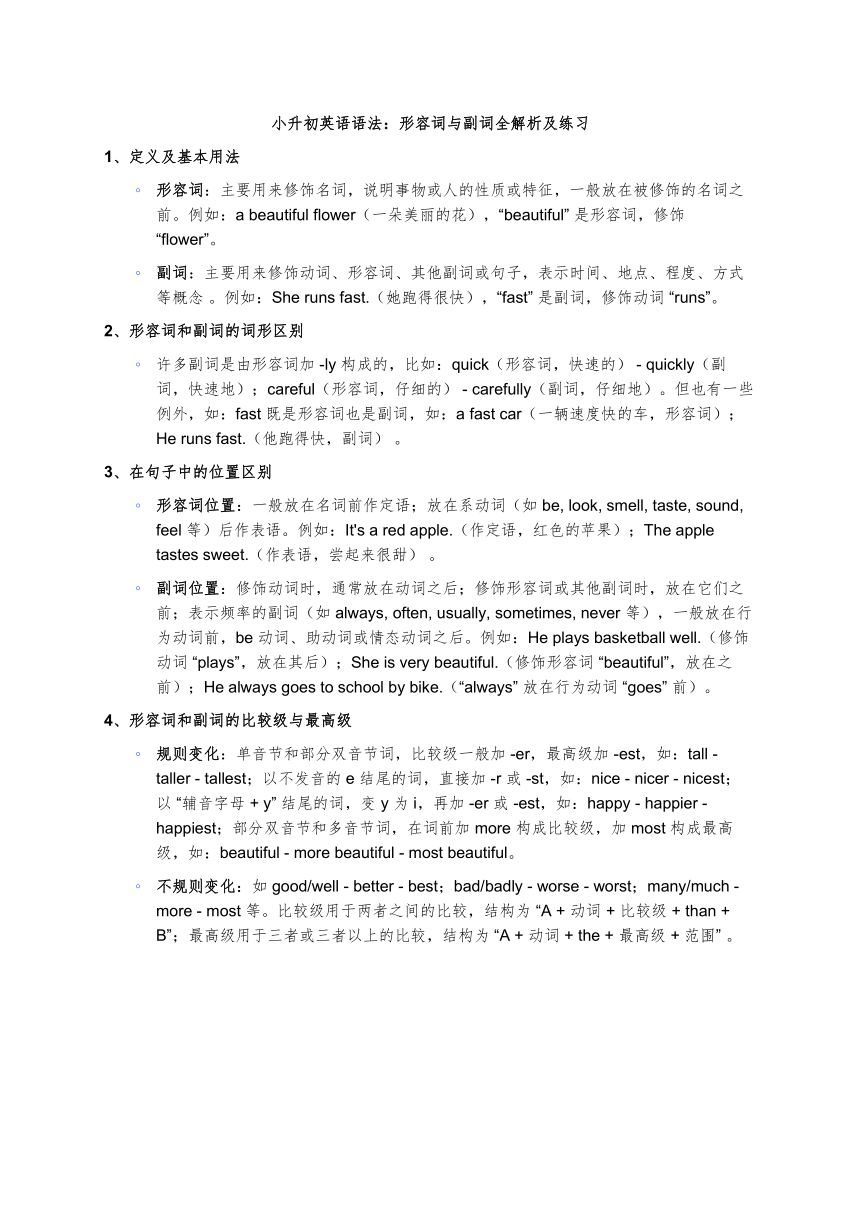
小升初英语语法:形容词与副词全解析及练习 1、定义及基本用法 形容词:主要用来修饰名词,说明事物或人的性质或特征,一般放在被修饰的名词之前。例如:a beautiful flower(一朵美丽的花),“beautiful” 是形容词,修饰 “flower”。 副词:主要用来修饰动词、形容词、其他副词或句子,表示时间、地点、程度、方式等概念 。例如:She runs fast.(她跑得很快),“fast” 是副词,修饰动词 “runs”。 2、形容词和副词的词形区别 许多副词是由形容词加 -ly 构成的,比如:quick(形容词,快速的) - quickly(副词,快速地);careful(形容词,仔细的) - carefully(副词,仔细地)。但也有一些例外,如:fast 既是形容词也是副词,如:a fast car(一辆速度快的车,形容词);He runs fast.(他跑得快,副词) 。 3、在句子中的位置区别 形容词位置:一般放在名词前作定语;放在系动词(如 be, look, smell, taste, sound, feel 等)后作表语。例如:It's a red apple.(作定语,红色的苹果);The apple tastes sweet.(作表语,尝起来很甜) 。 副词位置:修饰动词时,通常放在动词之后;修饰形容词或其他副词时,放在它们之前;表示频率的副词(如 always, often, usually, sometimes, never 等),一般放在行为动词前,be 动词、助动词或情态动词之后。例如:He plays basketball well.(修饰动词 “plays”,放在其后);She is very beautiful.(修饰形容词 “beautiful”,放在之前);He always goes to school by bike.(“always” 放在行为动词 “goes” 前)。 4、形容词和副词的比较级与最高级 规则变化:单音节和部分双音节词,比较级一般加 -er,最高级加 -est,如:tall - taller - tallest;以不发音的 e 结尾的词,直接加 -r 或 -st,如:nice - nicer - nicest;以 “辅音字母 + y” 结尾的词,变 y 为 i,再加 -er 或 -est,如:happy - happier - happiest;部分双音节和多音节词,在词前加 more 构成比较级,加 most 构成最高级,如:beautiful - more beautiful - most beautiful。 不规则变化:如 good/well - better - best;bad/badly - worse - worst;many/much - more - most 等。比较级用于两者之间的比较,结构为 “A + 动词 + 比较级 + than + B”;最高级用于三者或三者以上的比较,结构为 “A + 动词 + the + 最高级 + 范围” 。 形容词和副词练习题 The flower smells _____ (sweet/sweetly). She dances _____ (beautiful/beautifully). He is a _____ (careful/carefully) boy. The old man walks _____ (slow/slowly). The music sounds _____ (wonderful/wonderfully). Tom runs _____ (fast/fastly). The soup tastes _____ (delicious/deliciously). She speaks English _____ (fluent/fluently). It's a _____ (heavy/heavily) box. The rain is falling _____ (heavy/heavily). The story is very _____ (interest/interesting). He looks at me _____ (angry/angrily). The girl is _____ (quiet/quietly). He works _____ (hard/hardly). The movie is _____ (excite/exciting). She sings _____ (good/well). The boy is _____ (lucky/luckily). He writes _____ (neat/neatly). The day is _____ (sun/sunny). The wind is blowing _____ (strong/strongly). The problem seems _____ (easy/easily). They are _____ (happy/happily) children. She plays the piano _____ (bad/badly). The food smells _____ (terrible/terribly). He is _____ (quick/quickly) at math. The car is running _____ (smooth/smoothly). The teacher is _____ (patient/patiently) with ... ...
~~ 您好,已阅读到文档的结尾了 ~~

